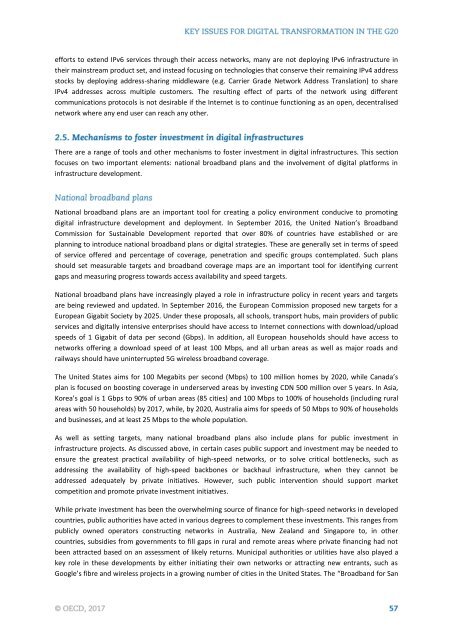KEY ISSUES FOR DIGITAL TRANSFORMATION IN THE G20
2jz0oUm
2jz0oUm
You also want an ePaper? Increase the reach of your titles
YUMPU automatically turns print PDFs into web optimized ePapers that Google loves.
efforts to extend IPv6 services through their access networks, many are not deploying IPv6 infrastructure in<br />
their mainstream product set, and instead focusing on technologies that conserve their remaining IPv4 address<br />
stocks by deploying address-sharing middleware (e.g. Carrier Grade Network Address Translation) to share<br />
IPv4 addresses across multiple customers. The resulting effect of parts of the network using different<br />
communications protocols is not desirable if the Internet is to continue functioning as an open, decentralised<br />
network where any end user can reach any other.<br />
There are a range of tools and other mechanisms to foster investment in digital infrastructures. This section<br />
focuses on two important elements: national broadband plans and the involvement of digital platforms in<br />
infrastructure development.<br />
National broadband plans are an important tool for creating a policy environment conducive to promoting<br />
digital infrastructure development and deployment. In September 2016, the United Nation’s Broadband<br />
Commission for Sustainable Development reported that over 80% of countries have established or are<br />
planning to introduce national broadband plans or digital strategies. These are generally set in terms of speed<br />
of service offered and percentage of coverage, penetration and specific groups contemplated. Such plans<br />
should set measurable targets and broadband coverage maps are an important tool for identifying current<br />
gaps and measuring progress towards access availability and speed targets.<br />
National broadband plans have increasingly played a role in infrastructure policy in recent years and targets<br />
are being reviewed and updated. In September 2016, the European Commission proposed new targets for a<br />
European Gigabit Society by 2025. Under these proposals, all schools, transport hubs, main providers of public<br />
services and digitally intensive enterprises should have access to Internet connections with download/upload<br />
speeds of 1 Gigabit of data per second (Gbps). In addition, all European households should have access to<br />
networks offering a download speed of at least 100 Mbps, and all urban areas as well as major roads and<br />
railways should have uninterrupted 5G wireless broadband coverage.<br />
The United States aims for 100 Megabits per second (Mbps) to 100 million homes by 2020, while Canada’s<br />
plan is focused on boosting coverage in underserved areas by investing CDN 500 million over 5 years. In Asia,<br />
Korea’s goal is 1 Gbps to 90% of urban areas (85 cities) and 100 Mbps to 100% of households (including rural<br />
areas with 50 households) by 2017, while, by 2020, Australia aims for speeds of 50 Mbps to 90% of households<br />
and businesses, and at least 25 Mbps to the whole population.<br />
As well as setting targets, many national broadband plans also include plans for public investment in<br />
infrastructure projects. As discussed above, in certain cases public support and investment may be needed to<br />
ensure the greatest practical availability of high-speed networks, or to solve critical bottlenecks, such as<br />
addressing the availability of high-speed backbones or backhaul infrastructure, when they cannot be<br />
addressed adequately by private initiatives. However, such public intervention should support market<br />
competition and promote private investment initiatives.<br />
While private investment has been the overwhelming source of finance for high-speed networks in developed<br />
countries, public authorities have acted in various degrees to complement these investments. This ranges from<br />
publicly owned operators constructing networks in Australia, New Zealand and Singapore to, in other<br />
countries, subsidies from governments to fill gaps in rural and remote areas where private financing had not<br />
been attracted based on an assessment of likely returns. Municipal authorities or utilities have also played a<br />
key role in these developments by either initiating their own networks or attracting new entrants, such as<br />
Google’s fibre and wireless projects in a growing number of cities in the United States. The “Broadband for San


